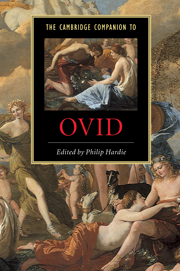19 - Recent receptions of Ovid
from Part 3 - Reception
Published online by Cambridge University Press: 28 May 2006
Summary
The task of mapping Ovid’s presence in the twentieth century, let alone a theoretical consideration of what might constitute that presence, has hardly begun. The Metamorphoses holds pride of place in the recent reception of Ovid, it may be granted; but in what ways is its presence to be defined? In a thematics of corporeal transformation, such as we see in Kafka’s Metamorphosis or David Garnett’s Lady into Fox? In explicit acknowledgement of the poet and his work? Extravagant (and sometimes perplexing) claims are made by, and on behalf of, writers and artists of the twentieth century for the influence of Ovid on their work. Notoriously in his note on line 218 of The Waste Land, T. S. Eliot invokes the figure of Tiresias, quotes 19 lines from the story told of him in Book 3 of the Metamorphoses, and suggests that 'although a mere spectator and not indeed a “character”, [Tiresias] is yet the most important personage in the poem, uniting all the rest … What Tiresias sees, in fact, is the substance of the poem.' James Joyce prefaced his Portrait of the Artist as a Young Man with a quotation from Ovid’s Metamorphoses, and he makes the reading of Ovid’s poem one of the formative factors in the education of its protagonist, Stephen Daedalus, but if we broaden our terms of reference to include a more general discourse of metamorphosis – manifested, for example, in the capacity of language through metaphor to ‘create as well as describe metamorphosis’ in its objects of reference – Joyce’s work (and not only his) can be seen to take on a more pervasive Ovidian character.
- Type
- Chapter
- Information
- The Cambridge Companion to Ovid , pp. 320 - 335Publisher: Cambridge University PressPrint publication year: 2002
- 4
- Cited by



